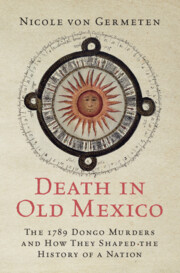Book contents
- Death in Old Mexico
- Death in Old Mexico
- Copyright page
- Contents
- Figures
- Tables
- Preface
- Acknowledgments
- Introduction
- Part I Murder
- Part II Context
- Part III Justice
- Part IV Characters
- Part V Consequences
- Part VI Interpretations
- 16 Violent City
- 17 Omens
- 18 Artifacts
- Part VII Texts
- Conclusion Death in Old Mexico
- Bibliography
- Index
18 - Artifacts
from Part VI - Interpretations
Published online by Cambridge University Press: 02 March 2023
- Death in Old Mexico
- Death in Old Mexico
- Copyright page
- Contents
- Figures
- Tables
- Preface
- Acknowledgments
- Introduction
- Part I Murder
- Part II Context
- Part III Justice
- Part IV Characters
- Part V Consequences
- Part VI Interpretations
- 16 Violent City
- 17 Omens
- 18 Artifacts
- Part VII Texts
- Conclusion Death in Old Mexico
- Bibliography
- Index
Summary
In the early 1790s, three momentous discoveries of Aztec monoliths took place in the Mexico City central plaza, now commonly known as the Zócalo. The stones reemerged into the light of day after centuries underground due to Viceroy Revillagigedo’s ambitious plans to renovate this plaza into a clean and organized space. He carried out this plan by removing market stalls, as well as trying to prevent flooding by installing and improving the stone paving in the zócalo and the surrounding streets. Workers on these projects uncovered dozens of artifacts, including the monoliths known today as the Stone of Tizoc, the Aztec Calendar Stone, and the Coatlicue statue. The emergence of the artifacts took place over the course of sixteenth months, from mid-August of 1790 to mid-December of 1791.
- Type
- Chapter
- Information
- Death in Old MexicoThe 1789 Dongo Murders and How They Shaped the History of a Nation, pp. 188 - 198Publisher: Cambridge University PressPrint publication year: 2023

